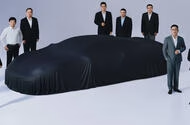Is Great Wall Motors Really Building a Supercar to Rival Ferrari and McLaren?
If you’ve been following the rise of Chinese automakers, you know they’re no longer content with just making affordable family cars. Now, Great Wall Motors (GWM)—the company behind the quirky Ora 03 and the rugged Haval Jolion Pro—has its sights set on something much more ambitious: a flagship supercar designed to take on the likes of Ferrari and McLaren. Sounds bold, right? Let’s dig into what’s really happening and why it matters.
What Sparked the Rumors About a GWM Supercar?
It all started with a bit of showmanship. To celebrate GWM’s 35th anniversary, company chairman Wei Jianjun posted a photo on Weibo (China’s answer to Twitter) that got car enthusiasts buzzing. The image? GWM’s top brass gathered around a mysterious, cloaked car with unmistakably sleek, mid-engined proportions. It was a classic teaser move, but it worked—speculation exploded overnight.
But this wasn’t just a one-off PR stunt. Earlier this year, GWM’s chief technology officer, Wu Huixiao, confirmed to Chinese media that the company had been quietly working on a supercar for five years. He let slip a few tantalizing details: the car will feature a carbon tub (think Formula 1-level rigidity and lightness) and, in his words, “will be better” than its European rivals. That’s a big claim, especially when you consider that GWM’s chairman has been spotted behind the wheel of a Ferrari SF90—a car that sets the bar for hybrid supercars.
How Does GWM’s Supercar Fit Into the Brand’s Strategy?
GWM isn’t just another upstart. Based in Hebei, it’s one of China’s oldest and largest automakers, delivering 1.23 million vehicles worldwide last year. The company has steadily expanded its portfolio, with brands ranging from the electric Ora to the premium Wey and the off-road-focused Tank. Now, GWM is launching a new, ultra-premium brand called Confidence Auto, which will sit above its existing marques. The goal? To compete head-to-head with BYD’s Yangwang, a luxury brand that’s already making waves in China and preparing for a European debut.
This move isn’t just about chasing prestige. It’s a strategic play to show that Chinese automakers can innovate at the very top end of the market, not just the entry level. If successful, it could shift global perceptions of what Chinese cars are capable of.
What Do We Know About the Powertrain and Performance?
Here’s where things get really interesting. GWM’s supercar is expected to be the first to use the company’s brand-new, self-developed 4.0-litre twin-turbo V8 engine, which made its debut at the Shanghai Motor Show earlier this year. While official specs are still under wraps, industry insiders suggest the engine could deliver up to 600 horsepower and 590 lb-ft of torque—impressive numbers that put it in the same league as some of Europe’s finest.
But that’s just the start. The combustion engine will be paired with a performance-focused plug-in hybrid system, similar to what you’ll find in the McLaren Artura or Ferrari 296 GTB. That means total output could soar well beyond the V8’s standalone figures, potentially rivaling the 1,250 horsepower of the all-electric BYD Yangwang U9. For context, the U9 can hit 240 mph and has lapped the Nürburgring in just 7 minutes and 18 seconds—making it one of the fastest production EVs to ever tackle the legendary German circuit.
Why Is GWM Targeting the Supercar Segment Now?
It’s no secret that the global auto industry is in the midst of a seismic shift. Electrification, advanced materials, and digital technology are leveling the playing field, allowing new players to challenge established giants. For GWM, launching a supercar isn’t just about making headlines—it’s about proving technical prowess and changing the narrative around Chinese vehicles.
There’s also a growing appetite for high-performance cars in China, which is now the world’s largest automotive market. According to a 2023 report from the China Association of Automobile Manufacturers, luxury and performance car sales in China have grown by more than 15 percent year-over-year, outpacing the broader market. GWM’s move is a calculated bet that Chinese consumers—and, soon, international buyers—are ready to embrace homegrown supercars.
When Will We See the GWM Supercar Unveiled?
While GWM hasn’t set an official reveal date, all signs point to the Guangzhou Motor Show at the end of November. This event is one of the biggest on China’s automotive calendar and would provide the perfect stage for such a high-profile debut. If the company follows through, expect a global media frenzy—and plenty of comparisons to Ferrari, McLaren, and Lamborghini.
What Sets GWM’s Approach Apart from European Rivals?
Beyond the headline-grabbing specs, GWM is taking a distinctly modern approach. By combining a lightweight carbon tub with a hybrid powertrain, the company is embracing the same formula that’s driving innovation in Europe. But there’s a twist: GWM’s supercar is likely to be priced more aggressively, making cutting-edge performance accessible to a broader audience.
And let’s not overlook the importance of homegrown technology. Developing a high-output V8 in-house is a major milestone for any automaker, let alone one that’s only recently entered the global performance conversation. If GWM can deliver on its promises, it could force established brands to take notice—and maybe even rethink their own strategies.
What Should Enthusiasts and Buyers Watch For Next?
As the reveal approaches, keep an eye out for more details on the car’s design, performance, and pricing. Will it match the raw speed of the Yangwang U9? Can it deliver the driving experience of a Ferrari or McLaren? And perhaps most importantly, will it signal a new era for Chinese performance cars on the world stage?
One thing’s for sure: GWM’s supercar project is more than just an engineering exercise. It’s a statement of intent—a bold move that could reshape the automotive landscape in ways we’re only beginning to imagine. Whether you’re a die-hard car enthusiast or just curious about where the industry is headed, this is one story you’ll want to follow closely.

